1 of 27
Downloaded 11 times

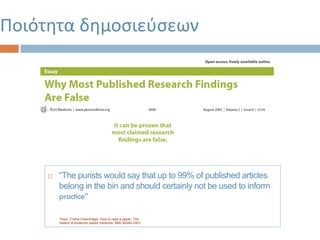

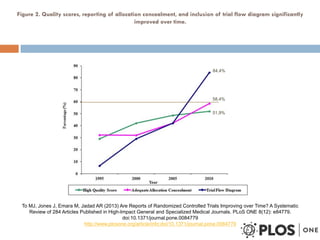
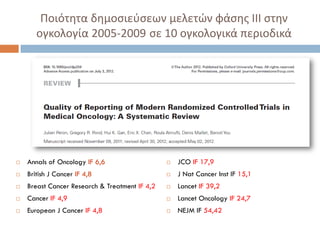

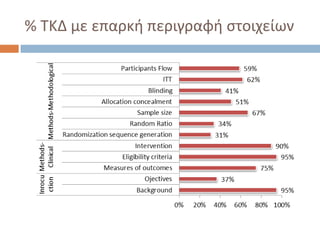


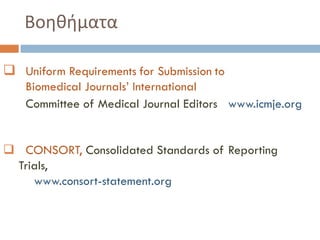

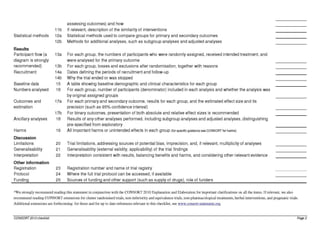

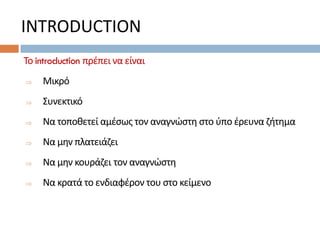


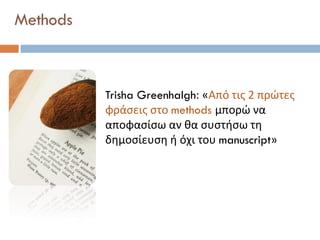
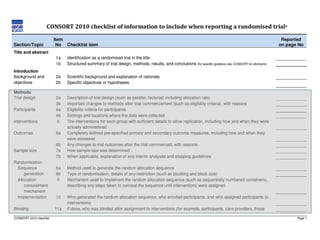
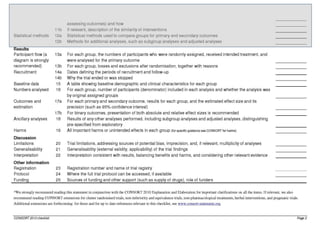


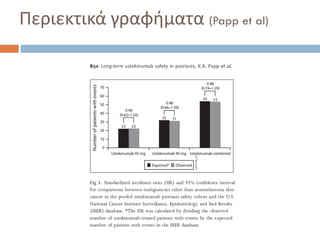

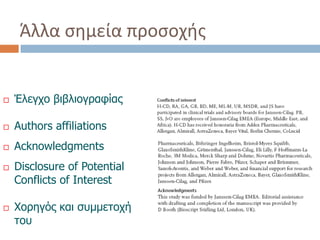



Ad
Recommended
Evidence Based Medicine - K.S. FIlos MD PhD
Evidence Based Medicine - K.S. FIlos MD PhDKriton Filos
╠²
How important is evidence based medicine in clinical practice nowadays? [ Presentation in greek]╬æ╬╗╬╗╬▒╬│╬« ╬Ü╬▒Žü╬╣╬ŁŽü╬▒Žé & ╬ĢŽü╬│╬▒Žā╬»╬▒ ŽāŽä╬┐ ╬Ģ╬ŠŽēŽä╬ĄŽü╬╣╬║Žī, CVexperts
╬æ╬╗╬╗╬▒╬│╬« ╬Ü╬▒Žü╬╣╬ŁŽü╬▒Žé & ╬ĢŽü╬│╬▒Žā╬»╬▒ ŽāŽä╬┐ ╬Ģ╬ŠŽēŽä╬ĄŽü╬╣╬║Žī, CVexpertsCVexperts - CV/LinkedIn Profile Writing & Career Consulting
╠²
╬æ╬╗╬╗╬▒╬│╬« ╬Ü╬▒Žü╬╣╬ŁŽü╬▒Žé & ╬ĢŽü╬│╬▒Žā╬»╬▒ ŽāŽä╬┐ ╬Ģ╬ŠŽēŽä╬ĄŽü╬╣╬║Žī, CVexperts - ╬ĢŽä╬▒╬╣Žü╬Ą╬»╬▒ ╬ŻŽģ╬│╬│Žü╬▒Žå╬«Žé ╬Æ╬╣╬┐╬│Žü╬▒Žå╬╣╬║ŽÄ╬Į & ╬ŻŽģ╬╝╬▓╬┐Žģ╬╗╬ĄŽģŽä╬╣╬║╬«Žé ╬Ü╬▒Žü╬╣╬ŁŽü╬▒Žé, ╬¤╬╝╬╣╬╗╬»╬▒ Žä╬ĘŽé CVexperts ŽāŽä╬╣Žé ╬Ā╬▒Žü╬¼╬╗╬╗╬Ę╬╗╬ĄŽé ╬Ģ╬║╬┤╬Ę╬╗ŽÄŽā╬Ą╬╣Žé ŽäŽē╬Į ╬Ś╬╝╬ĄŽüŽÄ╬Į ╬Ü╬▒Žü╬╣╬ŁŽü╬▒Žé 15 & 16 ╬¤╬║ŽäŽē╬▓Žü╬»╬┐Žģ 2011AgEdWS12 - Introduction to the Workshop
AgEdWS12 - Introduction to the WorkshopVassilis Protonotarios
╠²
The document outlines a workshop on agricultural education held by the Green Learning Network in Italy on October 25, 2012. It aims to bring together stakeholders to discuss methodologies, tools, and practices in agricultural education, which spans crop production, livestock management, and food education. The workshop includes sessions on content, collections, services, and hands-on activities, alongside providing resources through the Information Management Resource Kit (IMARK)."CV & LinkedIn for IT Professionals", IEEE University of Piraeus Student Branch
"CV & LinkedIn for IT Professionals", IEEE University of Piraeus Student BranchCVexperts - CV/LinkedIn Profile Writing & Career Consulting
╠²
Note from Maria Pafioli, CVexperts speaker:
"I presented particular techniques on how to design and build an effective CV for the students and graduates of the Department of Informatics. When it comes to jobs in the IT sector there is a certain format that will make sure your CV is picked up by a prospective employer. We talked about the particular Format - Technical Table (technologies you know) - Experience - Achievements - Hobbies/Interests (do not leave these out because they can provide some discussion points with your interviewers and give them a better feel for your personality - however they should be presented in the end of the CV very shortly).
Extra tips when preparing your CV:
- Your CV can be up to 2 pages in length.
- Take your time when preparing your CV.
- If there are any gaps in your CV give a brief explanation why (Traveling for a year, maternity leave etc) and be prepared to back everything up when being interviewed.
- Include online project portfolio or project showcase. In case you do not have it, prepare one.
After preparing your CV you should ask yourself:
- Does my CV look clear, neat and concise?
- Are there any spelling mistakes?
- Is my CV a close match to the job description?
- How does someone feel reading my CV?
- And finally, would I give myself the job?Doing business with Open Data in agriculture
Doing business with Open Data in agricultureVassilis Protonotarios
╠²
NEUROPUBLIC is a Greek company founded in 2003 that provides digital services for agriculture. It has established a coalition with farming organizations and a bank to support Greek agriculture through open data and technology. This coalition formed GAIA Business S.A., which offers various services to farmers through its GAIA cloud platform and network of environmental sensor stations. NEUROPUBLIC is building new business models and data-powered services for agriculture using open data sources like Copernicus data, remote sensing data, and data collected from its sensor network.╬¤╬╣ "╬╣╬┤╬Ł╬ĄŽé" ŽäŽē╬Į ╬╝╬▒╬Ė╬ĘŽäŽÄ╬Į
╬¤╬╣ "╬╣╬┤╬Ł╬ĄŽé" ŽäŽē╬Į ╬╝╬▒╬Ė╬ĘŽäŽÄ╬ĮNikos Papastamatiou
╠²
╬Ś ŽĆ╬▒Žü╬┐ŽģŽā╬»╬▒Žā╬Ę ┬½╬¤╬╣ ╬╣╬┤╬Ł╬ĄŽé ŽäŽē╬Į ╬╝╬▒╬Ė╬ĘŽäŽÄ╬Į ╬│╬╣╬▒ Žä╬╣Žé ╬Ł╬Į╬Į╬┐╬╣╬ĄŽé ╬║╬▒╬╣ Žä╬▒ Žå╬▒╬╣╬ĮŽī╬╝╬Ą╬Į╬▒ ŽäŽē╬Į Žå.╬Ą.┬╗ ╬Ą╬»╬Į╬▒╬╣ ╬╝╬╣╬▒ ╬Ą╬╣Žā╬▒╬│Žē╬│╬« ŽāŽä╬┐ ╬Ą╬Į ╬╗Žī╬│Žē ╬Ė╬Ł╬╝╬▒, Žä╬┐ ╬┐ŽĆ╬┐╬»╬┐ ŽĆ╬▒Žü╬┐ŽģŽā╬╣╬¼╬Č╬ĄŽä╬▒╬╣ ŽāŽģ╬Į╬┐ŽĆŽä╬╣╬║╬¼ ╬╝╬ŁŽāŽē ╬ĄŽĆ╬╣╬╗╬Ą╬│╬╝╬Ł╬ĮŽē╬Į ╬║╬▒╬╣ ŽāŽä╬┐Žć╬ĄŽģ╬╝╬Ł╬ĮŽē╬Į ŽĆ╬▒Žü╬▒╬┤╬Ą╬╣╬│╬╝╬¼ŽäŽē╬Į ╬╝╬Ą ŽĆ╬▒Žü╬▒ŽĆ╬┐╬╝ŽĆ╬ŁŽé ╬║╬▒╬╣ ŽāŽćŽī╬╗╬╣╬▒, ŽāŽä╬┐ ŽĆ╬╗╬▒╬»Žā╬╣╬┐ Žä╬ĘŽé ╬ĄŽĆ╬╣╬╝ŽīŽüŽåŽēŽā╬ĘŽé ŽäŽē╬Į ╬Ą╬║ŽĆ╬▒╬╣╬┤╬ĄŽģŽä╬╣╬║ŽÄ╬Į ŽāŽä╬Ę ŽćŽü╬«Žā╬Ę ╬║╬▒╬╣ ╬▒╬Š╬╣╬┐ŽĆ╬┐╬»╬ĘŽā╬Ę ŽäŽē╬Į ╬ż╬Ā╬Ģ ŽāŽä╬Ę╬Į Žä╬¼╬Š╬Ę (╬▓╬ä ╬ĄŽĆ╬»ŽĆ╬Ą╬┤╬┐). ╬ŻŽä╬┐ Žä╬Ł╬╗╬┐Žé ŽĆ╬▒Žü╬▒Žä╬»╬Ė╬ĄŽä╬▒╬╣ ╬Ą╬Į╬┤╬Ą╬╣╬║Žä╬╣╬║╬« ╬▓╬╣╬▓╬╗╬╣╬┐╬│Žü╬▒Žå╬»╬▒ ╬║╬▒╬╣ ╬┤╬╣╬║ŽäŽģ╬┐╬│Žü╬▒Žå╬»╬▒. ╬ĀŽüŽÄŽä╬Ę ŽĆ╬▒Žü╬┐ŽģŽā╬»╬▒Žā╬Ę: ╬æŽĆŽü╬»╬╗╬╣╬┐Žé 2011. ╬Ż╬Ę╬╝╬Ą╬╣╬▒╬║╬ŁŽé ŽĆŽü╬┐Žā╬Ė╬«╬║╬ĄŽé : ╬Ø╬┐╬Ł╬╝╬▓Žü╬╣╬┐Žé 2011.Qualitative Research Methods by Paulino Silva - ECSM2015
Qualitative Research Methods by Paulino Silva - ECSM2015Paulino Silva
╠²
The document provides an overview of qualitative research methods. It discusses how qualitative research aims to understand people's behaviors and perspectives through in-depth studies using techniques like interviews, observations, and case studies. The document outlines different approaches to qualitative research from various academic fields and compares it to quantitative research. It also discusses how qualitative research develops descriptive findings rather than predictive theories and is useful for answering questions about how and why.Qualitative research
Qualitative researchGavin Johnston
╠²
The document discusses the benefits of qualitative research over quantitative research. It notes that qualitative research provides a more in-depth understanding of human behavior through smaller, focused samples and investigates why and how people make decisions. An example is provided comparing a quantitative survey of 1,000 customers with a qualitative study that shadowed 15 customers, finding the qualitative research provided more actionable insights. These insights, such as customers' dislike of voicemail, helped improve a company's marketing strategy.Qualitative and Quantitative Research
Qualitative and Quantitative Researchgirlie
╠²
This document discusses key differences between qualitative and quantitative research methods. It provides definitions of common terms used in each approach and describes how qualitative studies are typically conducted. Qualitative research involves talking to or observing people with firsthand experience, analyzing data ongoing to guide further sampling and questions, and developing themes and theories from narrative findings. Qualitative reports often include verbatim excerpts from participants to support interpretations.Qualitative Research Method - an Introduction (updated jan 2011)
Qualitative Research Method - an Introduction (updated jan 2011)Hora Tjitra
╠²
This document provides an introduction to qualitative research methodology. It discusses key aspects of qualitative research such as what qualitative research refers to, common qualitative research paradigms, and differences between qualitative and quantitative research. The document also outlines the qualitative research process from developing research topics and questions to data collection and analysis. It provides examples of common qualitative research designs including field research, case studies, and action research. Data collection techniques in qualitative research like interviews and observation are also examined.An introduction to qualitative research
An introduction to qualitative researchNajibullah Safi
╠²
This document provides an introduction to qualitative research methods. It outlines some key differences between qualitative and quantitative research, including that qualitative research is subjective, holistic, and aims to understand why and how phenomena occur rather than objective measurements. It also describes some common qualitative research designs like phenomenology, ethnography, and grounded theory. The document then covers methods for collecting qualitative data through interviews, focus groups, observation, and documents. It provides guidance on analyzing, coding, and presenting the results of qualitative research.Quantitative and Qualitative Research
Quantitative and Qualitative ResearchMohammad Hassan
╠²
This document provides an overview of the key differences between quantitative and qualitative research methods. Quantitative research aims to test hypotheses and make predictions by studying specific variables through structured data collection from large randomly selected groups, which is then analyzed statistically. Qualitative research seeks to understand social phenomena through descriptive data like words and images collected from smaller non-random groups via open-ended questions, interviews and observations, with the goal of gaining insights rather than making generalized predictions.Qualitative Research Methods
Qualitative Research MethodsAntonio Dias de Figueiredo
╠²
This document provides an introduction to qualitative research methods in information sciences and technologies. It discusses the differences between quantitative and qualitative methods, noting that while traditionally seen as incompatible, they are actually complementary. Qualitative methods are increasingly used in fields like information systems and human-computer interaction due to the complex social and human factors involved. The document outlines some key aspects of quantitative and qualitative research approaches.Pass That Exam! Test Prep Strategies & Resources
Pass That Exam! Test Prep Strategies & ResourcesShelly Sanchez Terrell
╠²
The document discusses strategies and resources for effective test preparation, emphasizing the limitations of standardized tests in fully assessing individual value. It suggests various tools, apps, and approaches to familiarize students with testing formats, reduce anxiety, and enhance learning retention. Additionally, it highlights the importance of creating engaging and interactive study environments to motivate students.Qualitative Research
Qualitative ResearchUniversity of Maine
╠²
Qualitative research aims to understand people's experiences and interpretations of the world. It provides rich, detailed descriptions through methods like interviews, observations, and written responses. The researcher immerses themselves in the topic to understand perspectives without assumptions. Main types include case studies, grounded theory, phenomenology, and ethnography. Data collection involves interactions, written responses, and observations. Analysis begins during data collection to guide further inquiry. The process moves from specific to general understanding through a funnel or inductive approach. Validity is increased through triangulation of multiple data sources, types, and collection methods. Strengths include understanding context, but it is time consuming and results may not generalize. Mixed methods combine qualitative and quantitative approaches at different stages ofQuantitative And Qualitative Research
Quantitative And Qualitative Researchdoha07
╠²
Quantitative and qualitative research methods differ in important ways. Quantitative research uses statistical analysis of numeric data from standardized instruments, while qualitative research relies on descriptive analysis of text or image data collected from a small number of individuals. The two approaches also differ in how the research problem is identified, how literature is reviewed, how data is collected and analyzed, and how findings are reported. Common quantitative designs include experimental, correlational, and survey designs, while qualitative designs include grounded theory, ethnographic, narrative, and action research designs. The best approach depends on matching the research questions and goals.The Lean Startup Model for Healthcare
The Lean Startup Model for HealthcareHugh MASON
╠²
The document outlines a presentation on the lean startup model's relevance to healthcare, emphasizing its application for startups in Singapore. It discusses various macrotrends, the importance of business model innovation alongside scientific advancement, and provides insights on how to mitigate risks through a discovery-driven approach. Key conclusions stress the importance of understanding regulations, customer needs, and financing options early in the innovation process.Qualitative Research Methods
Qualitative Research MethodsJukka Peltokoski
╠²
The document provides an overview of a course on qualitative research methods. It discusses key topics that will be covered in the lectures, including what qualitative research is, different qualitative research strategies and how to implement them, methods for collecting data through observation and interviews, and analyzing qualitative data. The lectures will cover theory, qualitative research strategies and processes, data collection techniques, and critiques of qualitative research approaches.Science Experiments on Tablets
Science Experiments on TabletsMonica Burns
╠²
This document provides a list of tools and apps for science experiments and activities in K-8 classrooms. It includes apps for conducting experiments on the human body, sun, lake, and nano HD. Other apps allow students to access interactive science glossaries, learn about how things work, and explore elements and physics. Additional apps support writing, reading, and creating video guides and tutorials. The document promotes using tablets for hands-on science learning and documentation.The Future of Medical Education - Top Trends Likely to Have an Impact on the ...
The Future of Medical Education - Top Trends Likely to Have an Impact on the ...Ogilvy Health
╠²
The document summarizes key trends that are likely to impact the healthcare industry in the next decade based on a panel discussion with experts. Three major trends are: 1) Increased accountability and use of real-world data by pharmaceutical companies as patients have more medical information. 2) The rise of the "digitally enabled patient" as wearables and devices give patients and doctors more data to self-monitor health. 3) The impact of hyper-connected learners who will increasingly personalize their medical education online.Ten Characteristics Common To Highly Effective Entrepreneurs
Ten Characteristics Common To Highly Effective EntrepreneursAbhishek Shah
╠²
Wondering if you have what it takes to succeed as an entrepreneur? What separates those who launch and grow successful companies from less successful peers?
What trait do entrepreneurs like Bill Gates, Steve Jobs, Lawrence Ellison and Richard Branson have that the ordinary entrepreneurs don't?
The Thugs know it all. Check out this ║▌║▌▀ŻShare presentation from ThugStart.comQualitative and quantitative methods of research
Qualitative and quantitative methods of researchJordan Cruz
╠²
The document compares and contrasts qualitative and quantitative research methods. It discusses that qualitative research aims to understand social interactions through smaller, non-randomly selected samples, while quantitative research seeks to test hypotheses and make predictions using larger, randomly selected samples and specific variables. It also outlines the different types of data collected, forms of analysis, roles of researchers, and final reporting structures between the two methods.How do we see the healthcare's digital future and its impact on our lives?
How do we see the healthcare's digital future and its impact on our lives?Jane Vita
╠²
The document discusses the digital evolution of healthcare, highlighting ten key trends including empowered patients, resource scarcity, self-service, and open innovation. It emphasizes the importance of patient engagement, technology adoption, cost reduction through remote monitoring, and improved healthcare delivery models. The integration of gamification and mobility further enhances patient experience and access to care, marking a shift towards a more consumer-driven healthcare environment.Digital Portfolios
Digital Portfolios Silvia Rosenthal Tolisano
╠²
The document discusses the significance of digital portfolios in 21st-century education, emphasizing the need for students to manage their own online identities and showcase their learning through digital platforms. It highlights the changing nature of literacy and learning, advocating for students to actively reflect on their educational experiences. The author calls for a shift in educational practices to empower learners in today's technology-driven society.Recovery: Job Growth and Education Requirements Through 2020
Recovery: Job Growth and Education Requirements Through 2020CEW Georgetown
╠²
By 2020, the U.S. economy is expected to create 55 million job openings, with a majority requiring postsecondary education due to the retirement of baby boomers. The fastest growing job sectors will be in STEM, healthcare, and community services, while employers will value cognitive skills like communication and critical thinking. Most states currently fall short of the educational attainment needed for future job demands, highlighting the necessity for increased postsecondary education rates.╬£╬Ś ╬”╬æ╬Ī╬£╬æ╬Ü╬Ģ╬ź╬ż╬Ö╬Ü╬Ģ╬Ż ╬Ā╬æ╬Ī╬Ģ╬£╬Æ╬æ╬Ż╬Ģ╬Ö╬Ż ╬Ż╬ż╬Ś ╬ś╬Ģ╬Ī╬æ╬Ā╬Ģ╬ź╬ż╬Ö╬Ü╬Ś ╬ż╬¤╬ź ╬Ü╬æ╬Ī╬ö╬Ö╬¤╬£╬Ģ╬ż╬æ╬Æ╬¤╬ø╬Ö╬Ü╬¤╬ź ╬Ż╬ź╬Ø╬ö╬Ī╬¤╬£╬¤╬ź....
╬£╬Ś ╬”╬æ╬Ī╬£╬æ╬Ü╬Ģ╬ź╬ż╬Ö╬Ü╬Ģ╬Ż ╬Ā╬æ╬Ī╬Ģ╬£╬Æ╬æ╬Ż╬Ģ╬Ö╬Ż ╬Ż╬ż╬Ś ╬ś╬Ģ╬Ī╬æ╬Ā╬Ģ╬ź╬ż╬Ö╬Ü╬Ś ╬ż╬¤╬ź ╬Ü╬æ╬Ī╬ö╬Ö╬¤╬£╬Ģ╬ż╬æ╬Æ╬¤╬ø╬Ö╬Ü╬¤╬ź ╬Ż╬ź╬Ø╬ö╬Ī╬¤╬£╬¤╬ź....Miltiades Karavis
╠²
╬£╬ĄŽä╬▒╬▓╬┐╬╗╬╣╬║Žī ╬ŻŽŹ╬Į╬┤Žü╬┐┬Ą╬┐ (╬£╬ĄŽä╬Ż) ╬┐╬Į╬┐╬╝╬¼╬Č╬ĄŽä╬▒╬╣ ╬Ę ŽāŽģ╬ĮŽŹŽĆ╬▒Žü╬Š╬Ę ╬┤╬╣╬▒Žä╬▒Žü╬▒ŽćŽÄ╬Į Žä╬┐Žģ ╬╝╬ĄŽä╬▒╬▓╬┐╬╗╬╣Žā╬╝╬┐ŽŹ, ŽĆ╬┐Žģ ŽāŽģ╬Į╬ĄŽĆ╬¼╬│╬ĄŽä╬▒╬╣ ╬▒Žģ╬Š╬Ę╬╝╬Ł╬Į╬┐ ╬║╬»╬Į╬┤Žģ╬Į╬┐ ╬Ą╬╝Žå╬¼╬Į╬╣Žā╬ĘŽé Žā╬▒╬║Žć╬▒ŽüŽÄ╬┤╬Ę ╬┤╬╣╬▒╬▓╬«Žä╬Ę ╬║╬▒╬╣ ╬║╬▒Žü╬┤╬╣╬▒╬│╬│╬Ą╬╣╬▒╬║ŽÄ╬Į ╬Į╬┐Žā╬Ę╬╝╬¼ŽäŽē╬Į (ŽāŽä╬ĄŽå╬▒╬Į╬╣╬▒╬»╬▒Žé ╬ĮŽīŽā╬┐Žģ ╬Ż.╬Ø., ╬▒╬│╬│╬Ą╬╣╬▒╬║╬┐ŽŹ ╬Ą╬│╬║╬ĄŽå╬▒╬╗╬╣╬║╬┐ŽŹ ╬ĄŽĆ╬Ą╬╣Žā╬┐╬┤╬»╬┐Žģ ╬æ.╬Ģ.╬Ģ.).4-kliniko-peristatikodiatrofiki-parakolouthisi2021-2022.pdf
4-kliniko-peristatikodiatrofiki-parakolouthisi2021-2022.pdfssuser2ac964
╠²
╬Ü╬╗╬╣╬Į╬╣╬║Žī ŽĆ╬ĄŽü╬╣ŽāŽä╬▒Žä╬╣╬║ŽīMore Related Content
Viewers also liked (20)
╬¤╬╣ "╬╣╬┤╬Ł╬ĄŽé" ŽäŽē╬Į ╬╝╬▒╬Ė╬ĘŽäŽÄ╬Į
╬¤╬╣ "╬╣╬┤╬Ł╬ĄŽé" ŽäŽē╬Į ╬╝╬▒╬Ė╬ĘŽäŽÄ╬ĮNikos Papastamatiou
╠²
╬Ś ŽĆ╬▒Žü╬┐ŽģŽā╬»╬▒Žā╬Ę ┬½╬¤╬╣ ╬╣╬┤╬Ł╬ĄŽé ŽäŽē╬Į ╬╝╬▒╬Ė╬ĘŽäŽÄ╬Į ╬│╬╣╬▒ Žä╬╣Žé ╬Ł╬Į╬Į╬┐╬╣╬ĄŽé ╬║╬▒╬╣ Žä╬▒ Žå╬▒╬╣╬ĮŽī╬╝╬Ą╬Į╬▒ ŽäŽē╬Į Žå.╬Ą.┬╗ ╬Ą╬»╬Į╬▒╬╣ ╬╝╬╣╬▒ ╬Ą╬╣Žā╬▒╬│Žē╬│╬« ŽāŽä╬┐ ╬Ą╬Į ╬╗Žī╬│Žē ╬Ė╬Ł╬╝╬▒, Žä╬┐ ╬┐ŽĆ╬┐╬»╬┐ ŽĆ╬▒Žü╬┐ŽģŽā╬╣╬¼╬Č╬ĄŽä╬▒╬╣ ŽāŽģ╬Į╬┐ŽĆŽä╬╣╬║╬¼ ╬╝╬ŁŽāŽē ╬ĄŽĆ╬╣╬╗╬Ą╬│╬╝╬Ł╬ĮŽē╬Į ╬║╬▒╬╣ ŽāŽä╬┐Žć╬ĄŽģ╬╝╬Ł╬ĮŽē╬Į ŽĆ╬▒Žü╬▒╬┤╬Ą╬╣╬│╬╝╬¼ŽäŽē╬Į ╬╝╬Ą ŽĆ╬▒Žü╬▒ŽĆ╬┐╬╝ŽĆ╬ŁŽé ╬║╬▒╬╣ ŽāŽćŽī╬╗╬╣╬▒, ŽāŽä╬┐ ŽĆ╬╗╬▒╬»Žā╬╣╬┐ Žä╬ĘŽé ╬ĄŽĆ╬╣╬╝ŽīŽüŽåŽēŽā╬ĘŽé ŽäŽē╬Į ╬Ą╬║ŽĆ╬▒╬╣╬┤╬ĄŽģŽä╬╣╬║ŽÄ╬Į ŽāŽä╬Ę ŽćŽü╬«Žā╬Ę ╬║╬▒╬╣ ╬▒╬Š╬╣╬┐ŽĆ╬┐╬»╬ĘŽā╬Ę ŽäŽē╬Į ╬ż╬Ā╬Ģ ŽāŽä╬Ę╬Į Žä╬¼╬Š╬Ę (╬▓╬ä ╬ĄŽĆ╬»ŽĆ╬Ą╬┤╬┐). ╬ŻŽä╬┐ Žä╬Ł╬╗╬┐Žé ŽĆ╬▒Žü╬▒Žä╬»╬Ė╬ĄŽä╬▒╬╣ ╬Ą╬Į╬┤╬Ą╬╣╬║Žä╬╣╬║╬« ╬▓╬╣╬▓╬╗╬╣╬┐╬│Žü╬▒Žå╬»╬▒ ╬║╬▒╬╣ ╬┤╬╣╬║ŽäŽģ╬┐╬│Žü╬▒Žå╬»╬▒. ╬ĀŽüŽÄŽä╬Ę ŽĆ╬▒Žü╬┐ŽģŽā╬»╬▒Žā╬Ę: ╬æŽĆŽü╬»╬╗╬╣╬┐Žé 2011. ╬Ż╬Ę╬╝╬Ą╬╣╬▒╬║╬ŁŽé ŽĆŽü╬┐Žā╬Ė╬«╬║╬ĄŽé : ╬Ø╬┐╬Ł╬╝╬▓Žü╬╣╬┐Žé 2011.Qualitative Research Methods by Paulino Silva - ECSM2015
Qualitative Research Methods by Paulino Silva - ECSM2015Paulino Silva
╠²
The document provides an overview of qualitative research methods. It discusses how qualitative research aims to understand people's behaviors and perspectives through in-depth studies using techniques like interviews, observations, and case studies. The document outlines different approaches to qualitative research from various academic fields and compares it to quantitative research. It also discusses how qualitative research develops descriptive findings rather than predictive theories and is useful for answering questions about how and why.Qualitative research
Qualitative researchGavin Johnston
╠²
The document discusses the benefits of qualitative research over quantitative research. It notes that qualitative research provides a more in-depth understanding of human behavior through smaller, focused samples and investigates why and how people make decisions. An example is provided comparing a quantitative survey of 1,000 customers with a qualitative study that shadowed 15 customers, finding the qualitative research provided more actionable insights. These insights, such as customers' dislike of voicemail, helped improve a company's marketing strategy.Qualitative and Quantitative Research
Qualitative and Quantitative Researchgirlie
╠²
This document discusses key differences between qualitative and quantitative research methods. It provides definitions of common terms used in each approach and describes how qualitative studies are typically conducted. Qualitative research involves talking to or observing people with firsthand experience, analyzing data ongoing to guide further sampling and questions, and developing themes and theories from narrative findings. Qualitative reports often include verbatim excerpts from participants to support interpretations.Qualitative Research Method - an Introduction (updated jan 2011)
Qualitative Research Method - an Introduction (updated jan 2011)Hora Tjitra
╠²
This document provides an introduction to qualitative research methodology. It discusses key aspects of qualitative research such as what qualitative research refers to, common qualitative research paradigms, and differences between qualitative and quantitative research. The document also outlines the qualitative research process from developing research topics and questions to data collection and analysis. It provides examples of common qualitative research designs including field research, case studies, and action research. Data collection techniques in qualitative research like interviews and observation are also examined.An introduction to qualitative research
An introduction to qualitative researchNajibullah Safi
╠²
This document provides an introduction to qualitative research methods. It outlines some key differences between qualitative and quantitative research, including that qualitative research is subjective, holistic, and aims to understand why and how phenomena occur rather than objective measurements. It also describes some common qualitative research designs like phenomenology, ethnography, and grounded theory. The document then covers methods for collecting qualitative data through interviews, focus groups, observation, and documents. It provides guidance on analyzing, coding, and presenting the results of qualitative research.Quantitative and Qualitative Research
Quantitative and Qualitative ResearchMohammad Hassan
╠²
This document provides an overview of the key differences between quantitative and qualitative research methods. Quantitative research aims to test hypotheses and make predictions by studying specific variables through structured data collection from large randomly selected groups, which is then analyzed statistically. Qualitative research seeks to understand social phenomena through descriptive data like words and images collected from smaller non-random groups via open-ended questions, interviews and observations, with the goal of gaining insights rather than making generalized predictions.Qualitative Research Methods
Qualitative Research MethodsAntonio Dias de Figueiredo
╠²
This document provides an introduction to qualitative research methods in information sciences and technologies. It discusses the differences between quantitative and qualitative methods, noting that while traditionally seen as incompatible, they are actually complementary. Qualitative methods are increasingly used in fields like information systems and human-computer interaction due to the complex social and human factors involved. The document outlines some key aspects of quantitative and qualitative research approaches.Pass That Exam! Test Prep Strategies & Resources
Pass That Exam! Test Prep Strategies & ResourcesShelly Sanchez Terrell
╠²
The document discusses strategies and resources for effective test preparation, emphasizing the limitations of standardized tests in fully assessing individual value. It suggests various tools, apps, and approaches to familiarize students with testing formats, reduce anxiety, and enhance learning retention. Additionally, it highlights the importance of creating engaging and interactive study environments to motivate students.Qualitative Research
Qualitative ResearchUniversity of Maine
╠²
Qualitative research aims to understand people's experiences and interpretations of the world. It provides rich, detailed descriptions through methods like interviews, observations, and written responses. The researcher immerses themselves in the topic to understand perspectives without assumptions. Main types include case studies, grounded theory, phenomenology, and ethnography. Data collection involves interactions, written responses, and observations. Analysis begins during data collection to guide further inquiry. The process moves from specific to general understanding through a funnel or inductive approach. Validity is increased through triangulation of multiple data sources, types, and collection methods. Strengths include understanding context, but it is time consuming and results may not generalize. Mixed methods combine qualitative and quantitative approaches at different stages ofQuantitative And Qualitative Research
Quantitative And Qualitative Researchdoha07
╠²
Quantitative and qualitative research methods differ in important ways. Quantitative research uses statistical analysis of numeric data from standardized instruments, while qualitative research relies on descriptive analysis of text or image data collected from a small number of individuals. The two approaches also differ in how the research problem is identified, how literature is reviewed, how data is collected and analyzed, and how findings are reported. Common quantitative designs include experimental, correlational, and survey designs, while qualitative designs include grounded theory, ethnographic, narrative, and action research designs. The best approach depends on matching the research questions and goals.The Lean Startup Model for Healthcare
The Lean Startup Model for HealthcareHugh MASON
╠²
The document outlines a presentation on the lean startup model's relevance to healthcare, emphasizing its application for startups in Singapore. It discusses various macrotrends, the importance of business model innovation alongside scientific advancement, and provides insights on how to mitigate risks through a discovery-driven approach. Key conclusions stress the importance of understanding regulations, customer needs, and financing options early in the innovation process.Qualitative Research Methods
Qualitative Research MethodsJukka Peltokoski
╠²
The document provides an overview of a course on qualitative research methods. It discusses key topics that will be covered in the lectures, including what qualitative research is, different qualitative research strategies and how to implement them, methods for collecting data through observation and interviews, and analyzing qualitative data. The lectures will cover theory, qualitative research strategies and processes, data collection techniques, and critiques of qualitative research approaches.Science Experiments on Tablets
Science Experiments on TabletsMonica Burns
╠²
This document provides a list of tools and apps for science experiments and activities in K-8 classrooms. It includes apps for conducting experiments on the human body, sun, lake, and nano HD. Other apps allow students to access interactive science glossaries, learn about how things work, and explore elements and physics. Additional apps support writing, reading, and creating video guides and tutorials. The document promotes using tablets for hands-on science learning and documentation.The Future of Medical Education - Top Trends Likely to Have an Impact on the ...
The Future of Medical Education - Top Trends Likely to Have an Impact on the ...Ogilvy Health
╠²
The document summarizes key trends that are likely to impact the healthcare industry in the next decade based on a panel discussion with experts. Three major trends are: 1) Increased accountability and use of real-world data by pharmaceutical companies as patients have more medical information. 2) The rise of the "digitally enabled patient" as wearables and devices give patients and doctors more data to self-monitor health. 3) The impact of hyper-connected learners who will increasingly personalize their medical education online.Ten Characteristics Common To Highly Effective Entrepreneurs
Ten Characteristics Common To Highly Effective EntrepreneursAbhishek Shah
╠²
Wondering if you have what it takes to succeed as an entrepreneur? What separates those who launch and grow successful companies from less successful peers?
What trait do entrepreneurs like Bill Gates, Steve Jobs, Lawrence Ellison and Richard Branson have that the ordinary entrepreneurs don't?
The Thugs know it all. Check out this ║▌║▌▀ŻShare presentation from ThugStart.comQualitative and quantitative methods of research
Qualitative and quantitative methods of researchJordan Cruz
╠²
The document compares and contrasts qualitative and quantitative research methods. It discusses that qualitative research aims to understand social interactions through smaller, non-randomly selected samples, while quantitative research seeks to test hypotheses and make predictions using larger, randomly selected samples and specific variables. It also outlines the different types of data collected, forms of analysis, roles of researchers, and final reporting structures between the two methods.How do we see the healthcare's digital future and its impact on our lives?
How do we see the healthcare's digital future and its impact on our lives?Jane Vita
╠²
The document discusses the digital evolution of healthcare, highlighting ten key trends including empowered patients, resource scarcity, self-service, and open innovation. It emphasizes the importance of patient engagement, technology adoption, cost reduction through remote monitoring, and improved healthcare delivery models. The integration of gamification and mobility further enhances patient experience and access to care, marking a shift towards a more consumer-driven healthcare environment.Digital Portfolios
Digital Portfolios Silvia Rosenthal Tolisano
╠²
The document discusses the significance of digital portfolios in 21st-century education, emphasizing the need for students to manage their own online identities and showcase their learning through digital platforms. It highlights the changing nature of literacy and learning, advocating for students to actively reflect on their educational experiences. The author calls for a shift in educational practices to empower learners in today's technology-driven society.Recovery: Job Growth and Education Requirements Through 2020
Recovery: Job Growth and Education Requirements Through 2020CEW Georgetown
╠²
By 2020, the U.S. economy is expected to create 55 million job openings, with a majority requiring postsecondary education due to the retirement of baby boomers. The fastest growing job sectors will be in STEM, healthcare, and community services, while employers will value cognitive skills like communication and critical thinking. Most states currently fall short of the educational attainment needed for future job demands, highlighting the necessity for increased postsecondary education rates.Similar to Critical appraisal (14)
╬£╬Ś ╬”╬æ╬Ī╬£╬æ╬Ü╬Ģ╬ź╬ż╬Ö╬Ü╬Ģ╬Ż ╬Ā╬æ╬Ī╬Ģ╬£╬Æ╬æ╬Ż╬Ģ╬Ö╬Ż ╬Ż╬ż╬Ś ╬ś╬Ģ╬Ī╬æ╬Ā╬Ģ╬ź╬ż╬Ö╬Ü╬Ś ╬ż╬¤╬ź ╬Ü╬æ╬Ī╬ö╬Ö╬¤╬£╬Ģ╬ż╬æ╬Æ╬¤╬ø╬Ö╬Ü╬¤╬ź ╬Ż╬ź╬Ø╬ö╬Ī╬¤╬£╬¤╬ź....
╬£╬Ś ╬”╬æ╬Ī╬£╬æ╬Ü╬Ģ╬ź╬ż╬Ö╬Ü╬Ģ╬Ż ╬Ā╬æ╬Ī╬Ģ╬£╬Æ╬æ╬Ż╬Ģ╬Ö╬Ż ╬Ż╬ż╬Ś ╬ś╬Ģ╬Ī╬æ╬Ā╬Ģ╬ź╬ż╬Ö╬Ü╬Ś ╬ż╬¤╬ź ╬Ü╬æ╬Ī╬ö╬Ö╬¤╬£╬Ģ╬ż╬æ╬Æ╬¤╬ø╬Ö╬Ü╬¤╬ź ╬Ż╬ź╬Ø╬ö╬Ī╬¤╬£╬¤╬ź....Miltiades Karavis
╠²
╬£╬ĄŽä╬▒╬▓╬┐╬╗╬╣╬║Žī ╬ŻŽŹ╬Į╬┤Žü╬┐┬Ą╬┐ (╬£╬ĄŽä╬Ż) ╬┐╬Į╬┐╬╝╬¼╬Č╬ĄŽä╬▒╬╣ ╬Ę ŽāŽģ╬ĮŽŹŽĆ╬▒Žü╬Š╬Ę ╬┤╬╣╬▒Žä╬▒Žü╬▒ŽćŽÄ╬Į Žä╬┐Žģ ╬╝╬ĄŽä╬▒╬▓╬┐╬╗╬╣Žā╬╝╬┐ŽŹ, ŽĆ╬┐Žģ ŽāŽģ╬Į╬ĄŽĆ╬¼╬│╬ĄŽä╬▒╬╣ ╬▒Žģ╬Š╬Ę╬╝╬Ł╬Į╬┐ ╬║╬»╬Į╬┤Žģ╬Į╬┐ ╬Ą╬╝Žå╬¼╬Į╬╣Žā╬ĘŽé Žā╬▒╬║Žć╬▒ŽüŽÄ╬┤╬Ę ╬┤╬╣╬▒╬▓╬«Žä╬Ę ╬║╬▒╬╣ ╬║╬▒Žü╬┤╬╣╬▒╬│╬│╬Ą╬╣╬▒╬║ŽÄ╬Į ╬Į╬┐Žā╬Ę╬╝╬¼ŽäŽē╬Į (ŽāŽä╬ĄŽå╬▒╬Į╬╣╬▒╬»╬▒Žé ╬ĮŽīŽā╬┐Žģ ╬Ż.╬Ø., ╬▒╬│╬│╬Ą╬╣╬▒╬║╬┐ŽŹ ╬Ą╬│╬║╬ĄŽå╬▒╬╗╬╣╬║╬┐ŽŹ ╬ĄŽĆ╬Ą╬╣Žā╬┐╬┤╬»╬┐Žģ ╬æ.╬Ģ.╬Ģ.).4-kliniko-peristatikodiatrofiki-parakolouthisi2021-2022.pdf
4-kliniko-peristatikodiatrofiki-parakolouthisi2021-2022.pdfssuser2ac964
╠²
╬Ü╬╗╬╣╬Į╬╣╬║Žī ŽĆ╬ĄŽü╬╣ŽāŽä╬▒Žä╬╣╬║Žī╬Ģ╬╗╬ĄŽģ╬Ė╬ŁŽü╬╣╬┐Žé ╬ś╬ĘŽü╬▒╬»╬┐Žé, Clinical Research Conference 2018
╬Ģ╬╗╬ĄŽģ╬Ė╬ŁŽü╬╣╬┐Žé ╬ś╬ĘŽü╬▒╬»╬┐Žé, Clinical Research Conference 2018Starttech Ventures
╠²
╬¤╬╝╬╣╬╗╬»╬▒: ╬Ģ╬╗╬ĄŽģ╬Ė╬ŁŽü╬╣╬┐Žé ╬ś╬ĘŽü╬▒╬»╬┐Žé, MD, Msc in Public Health, ╬ō╬Ą╬Į╬╣╬║ŽīŽé ╬Ö╬▒ŽäŽüŽīŽé, ╬ö╬╣╬ĄŽģ╬ĖŽģ╬ĮŽä╬«Žé ╬Ģ╬Ż╬ź, ╬Ü╬Ł╬ĮŽäŽü╬┐ ╬ź╬│╬Ą╬»╬▒Žé ╬Æ╬¼Žü╬ĘŽé, ╬ō╬Ą╬Į╬╣╬║ŽīŽé ╬ōŽü╬▒╬╝╬╝╬▒Žä╬Ł╬▒Žé, ╬Ö╬▒ŽäŽü╬╣╬║╬« ╬ĢŽä╬▒╬╣Žü╬Ą╬»╬▒ ╬æ╬Ė╬Ę╬ĮŽÄ╬Į
╬ż╬»Žä╬╗╬┐Žé ╬┐╬╝╬╣╬╗╬»╬▒Žé: ┬½╬¤ ŽüŽī╬╗╬┐Žé ŽäŽē╬Į ╬£╬ĘŽäŽüŽÄŽē╬Į ╬æŽā╬Ė╬Ą╬ĮŽÄ╬Į ŽāŽä╬Ę╬Į ╬æ╬Š╬╣╬┐╬╗Žī╬│╬ĘŽā╬Ę ╬ż╬ĄŽć╬Į╬┐╬╗╬┐╬│╬╣ŽÄ╬Į ╬ź╬│╬Ą╬»╬▒Žé┬╗Digital Healthcare Quality Assurance
Digital Healthcare Quality AssuranceMichael Koutras
╠²
║▌║▌▀Żs Žā╬Ą ╬┐╬╝╬╣╬╗╬»╬▒ ŽāŽä╬┐ ╬æ╬ż╬ż╬Ö╬Ü╬¤ ╬Ø╬┐Žā╬┐╬║╬┐╬╝╬Ą╬»╬┐ ŽāŽä╬╣Žé 17/10/2010 ╬╝╬Ą ╬Ė╬Ł╬╝╬▒ "╬Ś╬╗╬Ą╬║ŽäŽü╬┐╬Į╬╣╬║╬¼ ╬ŻŽģŽāŽä╬«╬╝╬▒Žä╬▒ ŽāŽä╬┐ ŽćŽÄŽü╬┐ Žä╬ĘŽé ╬ź╬│╬Ą╬»╬▒Žé ╬║╬▒╬╣ ╬Ę Žā╬Ę╬╝╬▒Žā╬»╬▒ Žä╬┐ŽģŽé ŽāŽä╬Ę ╬ö╬╣╬▒ŽāŽå╬¼╬╗╬╣Žā╬Ę ╬Ā╬┐╬╣ŽīŽä╬ĘŽä╬▒Žé"╬Æ╬«╬╝╬▒ ╬æŽā╬║╬╗╬ĘŽĆ╬╣╬┐ŽŹ 18(1) 2019
╬Æ╬«╬╝╬▒ ╬æŽā╬║╬╗╬ĘŽĆ╬╣╬┐ŽŹ 18(1) 2019vangelisprekas
╠²
╬Ö╬║╬▒╬Į╬┐ŽĆ╬┐╬╣╬«Žā╬Ę ╬▒Žā╬Ė╬Ą╬ĮŽē╬Į Žā╬Ą ŽģŽĆ╬ĘŽü╬ĄŽā╬»╬ĄŽé ŽåŽģŽā╬╣╬║╬┐╬Ė╬ĄŽü╬▒ŽĆ╬Ą╬»╬▒ŽéHellenic Innovation Forum, ╬¢╬ŁŽå╬Ę ╬Æ╬┐ŽāŽä╬╣ŽäŽā╬¼╬Į╬┐Žģ
Hellenic Innovation Forum, ╬¢╬ŁŽå╬Ę ╬Æ╬┐ŽāŽä╬╣ŽäŽā╬¼╬Į╬┐ŽģStarttech Ventures
╠²
╬¤╬╝╬╣╬╗╬»╬▒ - ╬Ā╬▒Žü╬┐ŽģŽā╬»╬▒Žā╬Ę:
╬¢╬ŁŽå╬Ę ╬Æ╬┐ŽāŽä╬╣ŽäŽā╬¼╬Į╬┐Žģ, ╬ö╬╣╬ĄŽģ╬Ė. ╬ĢŽĆ╬╣ŽāŽä╬Ę╬╝╬┐╬Į╬╣╬║ŽÄ╬Į ╬║╬▒╬╣ ╬ÜŽģ╬▓╬ĄŽü╬Į╬ĘŽä╬╣╬║ŽÄ╬Į ╬ś╬Ą╬╝╬¼ŽäŽē╬Į, ╬ŻŽŹ╬Į╬┤╬ĄŽā╬╝╬┐Žé ╬”╬▒Žü╬╝╬▒╬║╬ĄŽģŽä╬╣╬║ŽÄ╬Į ╬ĢŽĆ╬╣Žć╬Ą╬╣Žü╬«Žā╬ĄŽē╬Į ╬Ģ╬╗╬╗╬¼╬┤╬┐Žé (╬Ż╬”╬Ģ╬Ģ)
┬½╬Ś ╬▒╬Š╬»╬▒ Žä╬ĘŽé ╬”╬▒Žü╬╝╬▒╬║╬ĄŽģŽä╬╣╬║╬«Žé ╬Ü╬▒╬╣╬Į╬┐Žä╬┐╬╝╬»╬▒Žé┬╗╬Ü╬▒Žü╬║╬»╬Į╬┐Žé ╬╝╬▒ŽāŽä╬┐ŽŹ Žā╬Ą ╬¼╬ĮŽäŽü╬ĄŽé ╬ÆŽī╬╗╬┐Žé 2015
╬Ü╬▒Žü╬║╬»╬Į╬┐Žé ╬╝╬▒ŽāŽä╬┐ŽŹ Žā╬Ą ╬¼╬ĮŽäŽü╬ĄŽé ╬ÆŽī╬╗╬┐Žé 2015Anastasios Boutis
╠²
╬Ü╬æ╬Ī╬Ü╬Ö╬Ø╬¤╬Ż ╬£╬æ╬Ż╬ż╬¤╬ź ╬Ż╬Ģ ╬æ╬Ø╬ż╬Ī╬Ģ╬Ż╬Į╬Ą╬┐ ╬▓╬▓╬╗╬╣╬▒Žü╬╣╬┐ ŽģŽĆ ŽāŽģ╬╝ŽĆ╬╗╬ĘŽüŽēŽā╬Ę 2017
╬Į╬Ą╬┐ ╬▓╬▓╬╗╬╣╬▒Žü╬╣╬┐ ŽģŽĆ ŽāŽģ╬╝ŽĆ╬╗╬ĘŽüŽēŽā╬Ę 2017psaltakis
╠²
╬¦Žü╬«Žā╬Ę ╬║╬▒╬╣ ╬ŻŽģ╬╝ŽĆ╬╗╬«ŽüŽēŽā╬Ę Žä╬┐Žģ ╬Į╬Ł╬┐Žģ ╬Æ╬╣╬▓╬╗╬╣╬▒Žü╬»╬┐Žģ ╬ź╬│╬Ą╬»╬▒Žé
29o ╬ŻŽģ╬Į╬Ł╬┤Žü╬╣╬┐ ╬Ā╬▒╬│╬║Žü╬«Žä╬╣╬▒Žé ╬Ā╬▒╬╣╬┤╬╣╬▒ŽäŽü╬╣╬║╬«Žé ╬ĢŽä╬▒╬╣Žü╬Ą╬»╬▒ŽéNext generation sequencing 2017
Next generation sequencing 2017psaltakis
╠²
╬ŻŽŹ╬│ŽćŽü╬┐╬Į╬Ę ╬ō╬Ą╬Į╬ĄŽä╬╣╬║╬« ╬ö╬╣╬¼╬│╬ĮŽēŽā╬Ę
29╬┐ ╬ŻŽģ╬Į╬Ł╬┤Žü╬╣╬┐ ╬Ā╬▒╬│╬║Žü╬«Žä╬╣╬▒Žé ╬Ā╬▒╬╣╬┤╬╣╬▒ŽäŽü╬╣╬║╬«Žé ╬ĢŽä╬▒╬╣Žü╬Ą╬»╬▒Žé╬£╬Ś ╬”╬æ╬Ī╬£╬æ╬Ü╬Ģ╬ź╬ż╬Ö╬Ü╬Ģ╬Ż ╬Ā╬æ╬Ī╬Ģ╬£╬Æ╬æ╬Ż╬Ģ╬Ö╬Ż ╬Ż╬ż╬Ś ╬ś╬Ģ╬Ī╬æ╬Ā╬Ģ╬ź╬ż╬Ö╬Ü╬Ś ╬ż╬¤╬ź ╬Ü╬æ╬Ī╬ö╬Ö╬¤╬£╬Ģ╬ż╬æ╬Æ╬¤╬ø╬Ö╬Ü╬¤╬ź ╬Ż╬ź╬Ø╬ö╬Ī╬¤╬£╬¤╬ź....
╬£╬Ś ╬”╬æ╬Ī╬£╬æ╬Ü╬Ģ╬ź╬ż╬Ö╬Ü╬Ģ╬Ż ╬Ā╬æ╬Ī╬Ģ╬£╬Æ╬æ╬Ż╬Ģ╬Ö╬Ż ╬Ż╬ż╬Ś ╬ś╬Ģ╬Ī╬æ╬Ā╬Ģ╬ź╬ż╬Ö╬Ü╬Ś ╬ż╬¤╬ź ╬Ü╬æ╬Ī╬ö╬Ö╬¤╬£╬Ģ╬ż╬æ╬Æ╬¤╬ø╬Ö╬Ü╬¤╬ź ╬Ż╬ź╬Ø╬ö╬Ī╬¤╬£╬¤╬ź....Miltiades Karavis
╠²
Ad
More from Athanasia Benekou (17)
Drug development phases
Drug development phasesAthanasia Benekou
╠²
Demo of the ppt: Phacrmaceutical research: drug developmentAbstract
AbstractAthanasia Benekou
╠²
This document provides instructions for writing an abstract. It states that abstracts should be no more than 300 words for reports of original data, reviews and meta-analyses. It should include a structured format with sections for background, methods, results and conclusions. For other major manuscripts, the abstract should be no more than 200 words and summarize the objective, main points and conclusions. Abstracts are not required for editorials, commentaries or some special features. It is important that nothing is included in the abstract that is not also in the main article and any abbreviations should be explained.Peer review process
Peer review processAthanasia Benekou
╠²
This document discusses the peer review process used by various biomedical journals. It notes that authors generally prefer double-blind peer review, where the identity of both the author and reviewer are unknown, while editors prefer single-blind review. The document also examines issues like the number of reviewers, who serves as reviewers, review timelines, and reviewer rewards. It provides some examples of journals that take different approaches to peer review, such as PLoS ONE which practices open peer review. The document concludes by arguing that scientific papers were historically anonymous and that journals should consider adopting more open peer review practices.A.Benekou Proposals For Trainings
A.Benekou Proposals For TrainingsAthanasia Benekou
╠²
This presentation contains suggestions for training agendas. From my large training portfolio you can create your own agenda that might best address your needs. Feel free to contact me for details!Ad
Recently uploaded (14)
KeimenoTelikhsGiortis-V1.pdf╬ŻŽć╬┐╬╗╬╣╬║Žī ╬ŁŽä╬┐Žé: 2024-2025
KeimenoTelikhsGiortis-V1.pdf╬ŻŽć╬┐╬╗╬╣╬║Žī ╬ŁŽä╬┐Žé: 2024-2025Tassos Karampinis
╠²
KeimenoTelikhsGiortis-V1.pdf
56o ╬ōŽģ╬╝╬Į╬¼Žā╬╣╬┐ ╬æ╬Ė╬«╬Į╬▒Žé
╬ŻŽć╬┐╬╗╬╣╬║Žī ╬ŁŽä╬┐Žé: 2024-2025╬æŽüŽć╬▒╬╣╠ü╬▒_╬æ_╬ōŽģ╬╝╬Į╬▒Žā╬»╬┐Žģ_╬Ģ╬ĮŽīŽä╬ĘŽä╬▒ 3_╬Ü╬Ą╬»╬╝╬Ą╬Į╬┐-ŽāŽćŽī╬╗╬╣╬▒.pptx
╬æŽüŽć╬▒╬╣╠ü╬▒_╬æ_╬ōŽģ╬╝╬Į╬▒Žā╬»╬┐Žģ_╬Ģ╬ĮŽīŽä╬ĘŽä╬▒ 3_╬Ü╬Ą╬»╬╝╬Ą╬Į╬┐-ŽāŽćŽī╬╗╬╣╬▒.pptxolymleng
╠²
╬æꎎć╬▒╬╣╠ü╬▒│Õ╬ō│Õ╬Ģ╬Į╬┐╠üŽä╬ĘŽä╬▒│Õ╬æ│Õ╬ōŽģ╬╝╬ĢŽü╬│╬▒Žā╬»╬▒ ╬Ż╬ż' Žä╬¼╬Š╬ĘŽé 2024-2025 (╬æŽåŽü╬╣╬║╬Ę2 Iman & ╬ż╬Č╬┐Žé).ppt
╬ĢŽü╬│╬▒Žā╬»╬▒ ╬Ż╬ż' Žä╬¼╬Š╬ĘŽé 2024-2025 (╬æŽåŽü╬╣╬║╬Ę2 Iman & ╬ż╬Č╬┐Žé).pptnikzoit
╠²
╬¤╬╣ ╬╝╬▒╬Ė╬ĘŽä╬ŁŽé Žä╬ĘŽé ╬Ż╬ż' Žä╬¼╬Š╬ĘŽé Žä╬┐Žģ 133╬┐Žģ ╬ö╬Ę╬╝╬┐Žä╬╣╬║╬┐ŽŹ ╬ŻŽć╬┐╬╗╬Ą╬»╬┐Žģ ╬æ╬Ė╬«╬Į╬▒Žé ŽāŽć╬Ą╬┤╬╣╬¼╬Č╬┐Žģ╬Į ╬Ł╬Į╬▒ ╬Ą╬▓╬┤╬┐╬╝╬▒╬┤╬╣╬▒╬»╬┐ Žä╬▒╬Š╬»╬┤╬╣ Žā╬Ą ╬╝╬»╬▒ ╬«ŽĆ╬Ą╬╣Žü╬┐.TelikiParousiasiSintaktikisFotografikisOEP.pdf
TelikiParousiasiSintaktikisFotografikisOEP.pdfTassos Karampinis
╠²
TelikiParousiasiSintaktikisFotografikisOEP.pdf
56o ╬ōŽģ╬╝╬Į╬¼Žā╬╣╬┐ ╬æ╬Ė╬«╬Į╬▒Žé
╬ŻŽć╬┐╬╗╬╣╬║Žī ╬ŁŽä╬┐Žé: 2024-2025╬Ś ╬£╬▒╬║╬▒Žü╬┐╬Į╬┐ŽĆ╬┐╬╗╬╣Žä╬Ą╬»╬▒ ŽäŽē╬Į ╬╝╬▒╬Ė╬ĘŽäŽÄ╬Į Žä╬ĘŽé ╬Æ Žä╬¼╬Š╬ĘŽé Žä╬┐Žģ ŽāŽć╬┐╬╗╬Ą╬»╬┐Žģ ╬╝╬▒Žé.pptx
╬Ś ╬£╬▒╬║╬▒Žü╬┐╬Į╬┐ŽĆ╬┐╬╗╬╣Žä╬Ą╬»╬▒ ŽäŽē╬Į ╬╝╬▒╬Ė╬ĘŽäŽÄ╬Į Žä╬ĘŽé ╬Æ Žä╬¼╬Š╬ĘŽé Žä╬┐Žģ ŽāŽć╬┐╬╗╬Ą╬»╬┐Žģ ╬╝╬▒Žé.pptx36dimperist
╠²
╬Ś ╬£╬▒╬║╬▒Žü╬┐╬Į╬┐ŽĆ╬┐╬╗╬╣Žä╬Ą╬»╬▒ ŽäŽē╬Į ╬╝╬▒╬Ė╬ĘŽäŽÄ╬Į Žä╬ĘŽé ╬Æ Žä╬¼╬Š╬ĘŽé Žä╬┐Žģ ŽāŽć╬┐╬╗╬Ą╬»╬┐Žģ ╬╝╬▒ŽéTelikiParousiasiPerivallontiko.pdf56o ╬ōŽģ╬╝╬Į╬¼Žā╬╣╬┐ ╬æ╬Ė╬«╬Į╬▒Žé
TelikiParousiasiPerivallontiko.pdf56o ╬ōŽģ╬╝╬Į╬¼Žā╬╣╬┐ ╬æ╬Ė╬«╬Į╬▒ŽéTassos Karampinis
╠²
TelikiParousiasiPerivallontiko.pdf
56o ╬ōŽģ╬╝╬Į╬¼Žā╬╣╬┐ ╬æ╬Ė╬«╬Į╬▒Žé
╬ŻŽć╬┐╬╗╬╣╬║Žī ╬ŁŽä╬┐Žé: 2024-2025╬▒╬Į╬▒ŽĆŽī╬╗╬ĘŽā╬Ę ŽäŽē╬Į ╬┤Žü╬▒ŽāŽä╬ĘŽü╬╣╬┐Žä╬«ŽäŽē╬Į Žä╬ĘŽé ╬ĄŽå╬Ę╬╝╬ĄŽü╬»╬┤╬▒Žé ╬╝╬▒Žé
╬▒╬Į╬▒ŽĆŽī╬╗╬ĘŽā╬Ę ŽäŽē╬Į ╬┤Žü╬▒ŽāŽä╬ĘŽü╬╣╬┐Žä╬«ŽäŽē╬Į Žä╬ĘŽé ╬ĄŽå╬Ę╬╝╬ĄŽü╬»╬┤╬▒Žé ╬╝╬▒Žé╬æŽåŽü╬┐╬┤╬»Žä╬Ę ╬ö╬╣╬▒╬╝╬▒╬ĮŽä╬┐ŽĆ╬┐ŽŹ╬╗╬┐Žģ
╠²
╬ī╬╗╬ĄŽé ╬┐╬╣ ╬┤Žü╬¼Žā╬Ą╬╣Žé ŽĆ╬┐Žģ ╬Ł╬│╬╣╬Į╬▒╬Į ŽāŽä╬┐ ŽĆ╬╗╬▒╬»Žā╬╣╬┐ Žä╬ĘŽé ŽāŽć╬┐╬╗╬╣╬║╬«Žé ╬ĄŽå╬Ę╬╝╬ĄŽü╬»╬┤╬▒Žé ╬┐╬╣ "╬Ģ╬Į╬▒╬╗╬╗╬▒╬║Žä╬╣╬║╬┐╬»"Marko Batista Temporary Objects And Hybrid Ambients Batista
Marko Batista Temporary Objects And Hybrid Ambients Batistandumuseika
╠²
Marko Batista Temporary Objects And Hybrid Ambients Batista
Marko Batista Temporary Objects And Hybrid Ambients Batista
Marko Batista Temporary Objects And Hybrid Ambients Batista╬æŽĆ╬┐Žć╬▒╬╣Žü╬ĄŽä╬╣ŽāŽä╬«Žü╬╣╬▒ ╬│╬╣╬┐ŽüŽä╬« ╬Ż╬ż╬ä Žä╬¼╬Š╬Ę - ╬ŻŽć╬┐╬╗╬╣╬║Žī ╬łŽä╬┐Žé 2024 - 2025.Žé.pptx
╬æŽĆ╬┐Žć╬▒╬╣Žü╬ĄŽä╬╣ŽāŽä╬«Žü╬╣╬▒ ╬│╬╣╬┐ŽüŽä╬« ╬Ż╬ż╬ä Žä╬¼╬Š╬Ę - ╬ŻŽć╬┐╬╗╬╣╬║Žī ╬łŽä╬┐Žé 2024 - 2025.Žé.pptx36dimperist
╠²
╬æŽĆŽī Žä╬Ę╬Į ╬▒ŽĆ╬┐Žć╬▒╬╣Žü╬ĄŽä╬╣ŽāŽä╬«Žü╬╣╬▒ ╬Ą╬║╬┤╬«╬╗ŽēŽā╬Ę ŽäŽē╬Į ╬╝╬▒╬Ė╬ĘŽäŽÄ╬Į Žä╬ĘŽé ╬Ż╬ż╬ä Žä╬¼╬Š╬ĘŽé Žä╬┐Žģ ŽāŽć╬┐╬╗╬Ą╬»╬┐Žģ ╬╝╬▒Žé. ╬ōŽģ╬╝╬Į╬¼Žā╬╣╬┐, ╬ĄŽüŽćŽī╬╝╬▒ŽāŽä╬Ą!!! ╬ö╬╣╬▒ŽäŽü╬┐Žå╬«- ╬ÜŽģ╬║╬╗╬▒╬┤╬╣╬║ŽīŽé ╬Ā╬┐╬╗╬╣Žä╬╣Žā╬╝ŽīŽé- ╬ō' ╬ö╬Ę╬╝╬┐Žä╬╣╬║╬┐ŽŹ.pptx
╬ö╬╣╬▒ŽäŽü╬┐Žå╬«- ╬ÜŽģ╬║╬╗╬▒╬┤╬╣╬║ŽīŽé ╬Ā╬┐╬╗╬╣Žä╬╣Žā╬╝ŽīŽé- ╬ō' ╬ö╬Ę╬╝╬┐Žä╬╣╬║╬┐ŽŹ.pptxssusera01664
╠²
╬ł╬Į╬▒ slidesahare ╬▓╬▒Žā╬╣Žā╬╝╬Ł╬Į╬┐ ŽāŽä╬┐ ŽĆŽüŽÄŽä╬┐ ╬╝╬¼╬Ė╬Ę╬╝╬▒ Žä╬ĘŽé Žī╬│╬┤╬┐╬ĘŽé ╬Ą╬ĮŽīŽä╬ĘŽä╬▒Žé Žä╬ĘŽé ╬ÖŽāŽä╬┐Žü╬»╬▒Žé ╬ō' ╬ö╬Ę╬╝╬┐Žä╬╣╬║╬┐ŽŹ Organizational Jazz Extraordinary Performance Through Extraordinary Leadershi...
Organizational Jazz Extraordinary Performance Through Extraordinary Leadershi...lgtbhrqejv2126
╠²
Organizational Jazz Extraordinary Performance Through Extraordinary Leadership David Napoli
Organizational Jazz Extraordinary Performance Through Extraordinary Leadership David Napoli
Organizational Jazz Extraordinary Performance Through Extraordinary Leadership David Napoli╬ĢŽü╬│╬▒Žā╬»╬ĄŽé ╬¤╬┤ŽŹŽāŽā╬Ą╬╣╬▒Žé, ╬æ1, ╬Ü╬┐Žü╬│╬╣╬▒╬╗╬Ł╬Į╬Ą╬╣╬┐ 1╬┐ ╬ōŽģ╬╝╬Į╬¼Žā╬╣╬┐ ╬æŽü╬│╬┐ŽāŽä╬┐╬╗╬»╬┐Žģ, 2024-25.pptx
╬ĢŽü╬│╬▒Žā╬»╬ĄŽé ╬¤╬┤ŽŹŽāŽā╬Ą╬╣╬▒Žé, ╬æ1, ╬Ü╬┐Žü╬│╬╣╬▒╬╗╬Ł╬Į╬Ą╬╣╬┐ 1╬┐ ╬ōŽģ╬╝╬Į╬¼Žā╬╣╬┐ ╬æŽü╬│╬┐ŽāŽä╬┐╬╗╬»╬┐Žģ, 2024-25.pptxEugenia Kosmatou
╠²
╬¤╬╣ ╬╝╬▒╬Ė╬ĘŽä╬ŁŽé/ŽäŽü╬╣╬ĄŽé ╬ČŽē╬│Žü╬¼Žå╬╣Žā╬▒╬Į ╬║╬▒╬╣ ╬║╬▒Žä╬▒Žā╬║╬ĄŽŹ╬▒Žā╬▒╬Į ŽāŽć╬Ą╬┤╬»╬ĄŽé ŽāŽä╬┐ ╬╝╬¼╬Ė╬Ę╬╝╬▒ Žä╬ĘŽé ╬¤╬┤ŽŹŽāŽā╬Ą╬╣╬▒Žé. ╬ż╬▒ ╬ŁŽü╬│╬▒ Žä╬┐ŽģŽé ╬▒ŽĆ╬┐ŽäŽģŽĆŽÄ╬Į╬┐╬ĮŽä╬▒╬╣ Žā╬Ą ╬▒ŽģŽäŽī Žä╬┐ p.p.Erasmus_Job_Shadowing_Full_Final_Presentation.pptx
Erasmus_Job_Shadowing_Full_Final_Presentation.pptxcnenou
╠²
Job shadowing in Albacete, erasmus+ accreditation╬ĢŽü╬│╬▒Žā╬»╬ĄŽé ╬¤╬┤ŽŹŽāŽā╬Ą╬╣╬▒Žé, ╬æ2, ╬Ü╬┐Žü╬│╬╣╬▒╬╗╬Ł╬Į╬Ą╬╣╬┐ 1╬┐ ╬ōŽģ╬╝╬Į╬¼Žā╬╣╬┐ ╬æŽü╬│╬┐ŽāŽä╬┐╬╗╬»╬┐Žģ, 2024-25.pptx
╬ĢŽü╬│╬▒Žā╬»╬ĄŽé ╬¤╬┤ŽŹŽāŽā╬Ą╬╣╬▒Žé, ╬æ2, ╬Ü╬┐Žü╬│╬╣╬▒╬╗╬Ł╬Į╬Ą╬╣╬┐ 1╬┐ ╬ōŽģ╬╝╬Į╬¼Žā╬╣╬┐ ╬æŽü╬│╬┐ŽāŽä╬┐╬╗╬»╬┐Žģ, 2024-25.pptxEugenia Kosmatou
╠²
╬¤╬╣ ╬╝╬▒╬Ė╬ĘŽä╬ŁŽé/ŽäŽü╬╣╬ĄŽé ╬ČŽē╬│Žü╬¼Žå╬╣Žā╬▒╬Į ╬║╬▒╬╣ ╬║╬▒Žä╬▒Žā╬║╬ĄŽŹ╬▒Žā╬▒╬Į ŽāŽć╬Ą╬┤╬»╬ĄŽé ŽāŽä╬┐ ╬╝╬¼╬Ė╬Ę╬╝╬▒ Žä╬ĘŽé ╬¤╬┤ŽŹŽāŽā╬Ą╬╣╬▒Žé. ╬ż╬▒ ╬ŁŽü╬│╬▒ Žä╬┐ŽģŽé ╬▒ŽĆ╬┐ŽäŽģŽĆŽÄ╬Į╬┐╬ĮŽä╬▒╬╣ Žā╬Ą ╬▒ŽģŽäŽī Žä╬┐ p.p.╬Ś ╬£╬▒╬║╬▒Žü╬┐╬Į╬┐ŽĆ╬┐╬╗╬╣Žä╬Ą╬»╬▒ ŽäŽē╬Į ╬╝╬▒╬Ė╬ĘŽäŽÄ╬Į Žä╬ĘŽé ╬Æ Žä╬¼╬Š╬ĘŽé Žä╬┐Žģ ŽāŽć╬┐╬╗╬Ą╬»╬┐Žģ ╬╝╬▒Žé.pptx
╬Ś ╬£╬▒╬║╬▒Žü╬┐╬Į╬┐ŽĆ╬┐╬╗╬╣Žä╬Ą╬»╬▒ ŽäŽē╬Į ╬╝╬▒╬Ė╬ĘŽäŽÄ╬Į Žä╬ĘŽé ╬Æ Žä╬¼╬Š╬ĘŽé Žä╬┐Žģ ŽāŽć╬┐╬╗╬Ą╬»╬┐Žģ ╬╝╬▒Žé.pptx36dimperist
╠²
╬▒╬Į╬▒ŽĆŽī╬╗╬ĘŽā╬Ę ŽäŽē╬Į ╬┤Žü╬▒ŽāŽä╬ĘŽü╬╣╬┐Žä╬«ŽäŽē╬Į Žä╬ĘŽé ╬ĄŽå╬Ę╬╝╬ĄŽü╬»╬┤╬▒Žé ╬╝╬▒Žé
╬▒╬Į╬▒ŽĆŽī╬╗╬ĘŽā╬Ę ŽäŽē╬Į ╬┤Žü╬▒ŽāŽä╬ĘŽü╬╣╬┐Žä╬«ŽäŽē╬Į Žä╬ĘŽé ╬ĄŽå╬Ę╬╝╬ĄŽü╬»╬┤╬▒Žé ╬╝╬▒Žé╬æŽåŽü╬┐╬┤╬»Žä╬Ę ╬ö╬╣╬▒╬╝╬▒╬ĮŽä╬┐ŽĆ╬┐ŽŹ╬╗╬┐Žģ
╠²
╬æŽĆ╬┐Žć╬▒╬╣Žü╬ĄŽä╬╣ŽāŽä╬«Žü╬╣╬▒ ╬│╬╣╬┐ŽüŽä╬« ╬Ż╬ż╬ä Žä╬¼╬Š╬Ę - ╬ŻŽć╬┐╬╗╬╣╬║Žī ╬łŽä╬┐Žé 2024 - 2025.Žé.pptx
╬æŽĆ╬┐Žć╬▒╬╣Žü╬ĄŽä╬╣ŽāŽä╬«Žü╬╣╬▒ ╬│╬╣╬┐ŽüŽä╬« ╬Ż╬ż╬ä Žä╬¼╬Š╬Ę - ╬ŻŽć╬┐╬╗╬╣╬║Žī ╬łŽä╬┐Žé 2024 - 2025.Žé.pptx36dimperist
╠²
╬ö╬╣╬▒ŽäŽü╬┐Žå╬«- ╬ÜŽģ╬║╬╗╬▒╬┤╬╣╬║ŽīŽé ╬Ā╬┐╬╗╬╣Žä╬╣Žā╬╝ŽīŽé- ╬ō' ╬ö╬Ę╬╝╬┐Žä╬╣╬║╬┐ŽŹ.pptx
╬ö╬╣╬▒ŽäŽü╬┐Žå╬«- ╬ÜŽģ╬║╬╗╬▒╬┤╬╣╬║ŽīŽé ╬Ā╬┐╬╗╬╣Žä╬╣Žā╬╝ŽīŽé- ╬ō' ╬ö╬Ę╬╝╬┐Žä╬╣╬║╬┐ŽŹ.pptxssusera01664
╠²
╬ĢŽü╬│╬▒Žā╬»╬ĄŽé ╬¤╬┤ŽŹŽāŽā╬Ą╬╣╬▒Žé, ╬æ1, ╬Ü╬┐Žü╬│╬╣╬▒╬╗╬Ł╬Į╬Ą╬╣╬┐ 1╬┐ ╬ōŽģ╬╝╬Į╬¼Žā╬╣╬┐ ╬æŽü╬│╬┐ŽāŽä╬┐╬╗╬»╬┐Žģ, 2024-25.pptx
╬ĢŽü╬│╬▒Žā╬»╬ĄŽé ╬¤╬┤ŽŹŽāŽā╬Ą╬╣╬▒Žé, ╬æ1, ╬Ü╬┐Žü╬│╬╣╬▒╬╗╬Ł╬Į╬Ą╬╣╬┐ 1╬┐ ╬ōŽģ╬╝╬Į╬¼Žā╬╣╬┐ ╬æŽü╬│╬┐ŽāŽä╬┐╬╗╬»╬┐Žģ, 2024-25.pptxEugenia Kosmatou
╠²
╬ĢŽü╬│╬▒Žā╬»╬ĄŽé ╬¤╬┤ŽŹŽāŽā╬Ą╬╣╬▒Žé, ╬æ2, ╬Ü╬┐Žü╬│╬╣╬▒╬╗╬Ł╬Į╬Ą╬╣╬┐ 1╬┐ ╬ōŽģ╬╝╬Į╬¼Žā╬╣╬┐ ╬æŽü╬│╬┐ŽāŽä╬┐╬╗╬»╬┐Žģ, 2024-25.pptx
╬ĢŽü╬│╬▒Žā╬»╬ĄŽé ╬¤╬┤ŽŹŽāŽā╬Ą╬╣╬▒Žé, ╬æ2, ╬Ü╬┐Žü╬│╬╣╬▒╬╗╬Ł╬Į╬Ą╬╣╬┐ 1╬┐ ╬ōŽģ╬╝╬Į╬¼Žā╬╣╬┐ ╬æŽü╬│╬┐ŽāŽä╬┐╬╗╬»╬┐Žģ, 2024-25.pptxEugenia Kosmatou
╠²
Critical appraisal
- 1. ╬Ü╬Ī╬Ö╬ż╬Ö╬Ü╬Ś ╬æ╬×╬Ö╬¤╬ø╬¤╬ō╬Ś╬Ż╬Ś ╬ż╬®╬Ø ╬ö╬Ś╬£╬¤╬Ż╬Ö╬Ģ╬ź╬Ż╬Ģ╬®╬Ø ╬æ╬Ė╬▒╬Į╬▒Žā╬»╬▒ ╬£ŽĆ╬Ą╬Į╬Ł╬║╬┐Žģ MedicalWriter abenekou.net medical.papers@abenekou.net
- 2. ’é© ŌĆ£The purists would say that up to 99% of published articles belong in the bin and should certainly not be used to inform practiceŌĆØ ╬Ā╬┐╬╣ŽīŽä╬ĘŽä╬▒ ╬┤╬Ę╬╝╬┐Žā╬╣╬ĄŽŹŽā╬ĄŽē╬Į ╬Ā╬Ę╬│╬«: Trisha Greenhalgh. How to read a paper. The basics of evidence based medicine. BMJ Books 2001
- 3. ╬Ā╬┐╬╣ŽīŽä╬ĘŽä╬▒ ╬ż╬Ü╬ö Žā╬Ą ŽĆ╬ĄŽü╬╣╬┐╬┤╬╣╬║╬¼ ╬╝╬Ą ŽģŽł╬Ę╬╗Žī IF ’é© BMJ IF 17,2 ’é© CMAJ IF 6,5 ’é© JAMA IF 30 ’é© Lancet IF 39,2 ’é© NEJM IF 54,2 ’é© Am J Respiratory & Critical Care Med IF 11,0 ’é© Arch General Psychiatry IF 13,8 ’é© Circulation IF 15,2 ’é© Diabetes IF 8,3 ’é© J Clin Oncology IF 17,9
- 4. Figure 2. Quality scores, reporting of allocation concealment, and inclusion of trial flow diagram significantly improved over time. To MJ, Jones J, Emara M, Jadad AR (2013) Are Reports of Randomized Controlled Trials Improving over Time? A Systematic Review of 284 Articles Published in High-Impact General and Specialized Medical Journals. PLoS ONE 8(12): e84779. doi:10.1371/journal.pone.0084779 http://www.plosone.org/article/info:doi/10.1371/journal.pone.0084779 51,9% 58,4% 84,4%
- 5. ’é© Annals of Oncology IF 6,6 ’é© British J Cancer IF 4,8 ’é© Breast Cancer Research & Treatment IF 4,2 ’é© Cancer IF 4,9 ’é© European J Cancer IF 4,8 ’é© JCO IF 17,9 ’é© J Nat Cancer Inst IF 15,1 ’é© Lancet IF 39,2 ’é© Lancet Oncology IF 24,7 ’é© NEJM IF 54,42 ╬Ā╬┐╬╣ŽīŽä╬ĘŽä╬▒ ╬┤╬Ę╬╝╬┐Žā╬╣╬ĄŽŹŽā╬ĄŽē╬Į ╬╝╬Ą╬╗╬ĄŽäŽÄ╬Į Žå╬¼Žā╬ĘŽé ╬Ö╬Ö╬Ö ŽāŽä╬Ę╬Į ╬┐╬│╬║╬┐╬╗╬┐╬│╬»╬▒ 2005-2009 Žā╬Ą 10 ╬┐╬│╬║╬┐╬╗╬┐╬│╬╣╬║╬¼ ŽĆ╬ĄŽü╬╣╬┐╬┤╬╣╬║╬¼
- 6. % ╬ż╬Ü╬ö ╬╝╬Ą ╬ĄŽĆ╬▒Žü╬║╬« ŽĆ╬ĄŽü╬╣╬│Žü╬▒Žå╬« ŽāŽä╬┐╬╣Žć╬Ą╬»Žē╬Į
- 7. % ╬ż╬Ü╬ö ╬╝╬Ą ╬ĄŽĆ╬▒Žü╬║╬« ŽĆ╬ĄŽü╬╣╬│Žü╬▒Žå╬« ŽāŽä╬┐╬╣Žć╬Ą╬»Žē╬Į
- 8. % ╬ż╬Ü╬ö ╬╝╬Ą ╬ĄŽĆ╬▒Žü╬║╬« ŽĆ╬ĄŽü╬╣╬│Žü╬▒Žå╬« ŽāŽä╬┐╬╣Žć╬Ą╬»Žē╬Į Žä╬ĘŽé ╬╝╬Ą╬╗╬ŁŽä╬ĘŽé ŽĆ╬┐Žģ ╬║╬▒╬Ė╬┐Žü╬»╬Č╬┐Žģ╬Į Žä╬Ę╬Į ŽĆ╬┐╬╣ŽīŽä╬ĘŽä╬¼Žé Žä╬ĘŽé ╬Ā╬Ę╬│╬ŁŽé: 1. Methodological reporting of randomized controlled trials in major hepato-gastroenterology journals in 2008 and 1998: a comparative study. Wang Ji-Lin et al. BMC Medical Research Methodology 2011,11:110 2. Quality of reporting of modern RCTs in medical oncology: a systematic review. Peron J.ate al. J Natl Cancer Inst 2012;104:982ŌĆō989
- 9. ’ü▒ ╬ō╬╣╬▒Žä╬» ╬║╬▒╬║╬ŁŽé ╬┤╬Ę╬╝╬┐Žā╬╣╬ĄŽŹŽā╬Ą╬╣Žé ŽģŽĆ╬¼ŽüŽć╬┐Žģ╬Į Žā╬Ą Žī╬╗╬▒ Žä╬▒ ╬ĄŽĆ╬╣ŽāŽä╬Ę╬╝╬┐╬Į╬╣╬║╬¼ ŽĆ╬ĄŽü╬╣╬┐╬┤╬╣╬║╬¼ ’ü▒ ╬ż╬┐ ŽģŽł╬Ę╬╗Žī impact factor Žä╬┐Žģ ŽĆ╬ĄŽü╬╣╬┐╬┤╬╣╬║╬┐ŽŹ ╬║╬▒╬╣ Žä╬┐ peer review process ╬┤╬Ą╬Į ╬Ą╬»╬Į╬▒╬╣ ╬Ą╬│╬│Žģ╬ĘŽä╬ŁŽé ŽĆ╬┐╬╣ŽīŽä╬ĘŽä╬▒Žé ’ü▒ ╬ō╬╣╬▒Žä╬» ╬Ą╬╝╬Ą╬»Žé ╬▒ŽĆ╬┐Žå╬▒Žā╬»╬Č╬┐Žģ╬╝╬Ą ╬▒╬Į ╬╝╬▒Žé ╬Ą╬»╬Į╬▒╬╣ ŽćŽü╬«Žā╬╣╬╝╬Ę ╬╝╬╣╬▒ ╬┤╬Ę╬╝╬┐Žā╬»╬ĄŽģŽā╬Ę ╬æŽå╬┐ŽŹ ╬┐╬╣ ╬┤╬Ę╬╝╬┐Žā╬╣╬ĄŽŹŽā╬Ą╬╣Žé ╬ŁŽć╬┐Žģ╬Į ŽģŽĆ╬┐ŽāŽä╬Ą╬» Peer review ╬│╬╣╬▒Žä╬» ╬Ą╬╝╬Ą╬»Žé ╬Į╬▒ Žä╬╣Žé ╬▒╬Š╬╣╬┐╬╗╬┐╬│╬┐ŽŹ╬╝╬Ą;
- 10. ╬Æ╬┐╬Ę╬Ė╬«╬╝╬▒Žä╬▒ ’ü▒ ŌĆś Uniform Requirements for Submission to Biomedical JournalsŌĆÖ International Committee of Medical Journal Editors www.icmje.org ’ü▒ CONSORT, Consolidated Standards of Reporting Trials, www.consort-statement.org
- 13. Introduction
- 14. INTRODUCTION ╬ż╬┐ introduction ŽĆŽü╬ŁŽĆ╬Ą╬╣ ╬Į╬▒ ╬Ą╬»╬Į╬▒╬╣ ’ā× ╬£╬╣╬║ŽüŽī ’ā× ╬ŻŽģ╬Į╬Ą╬║Žä╬╣╬║Žī ’ā× ╬Ø╬▒ Žä╬┐ŽĆ╬┐╬Ė╬ĄŽä╬Ą╬» ╬▒╬╝╬ŁŽāŽēŽé Žä╬┐╬Į ╬▒╬Į╬▒╬│╬ĮŽÄŽāŽä╬Ę ŽāŽä╬┐ ŽŹŽĆ╬┐ ╬ŁŽü╬ĄŽģ╬Į╬▒ ╬Č╬«Žä╬Ę╬╝╬▒ ’ā× ╬Ø╬▒ ╬╝╬Ę╬Į ŽĆ╬╗╬▒Žä╬Ą╬╣╬¼╬Č╬Ą╬╣ ’ā× ╬Ø╬▒ ╬╝╬Ę╬Į ╬║╬┐ŽģŽü╬¼╬Č╬Ą╬╣ Žä╬┐╬Į ╬▒╬Į╬▒╬│╬ĮŽÄŽāŽä╬Ę ’ā× ╬Ø╬▒ ╬║Žü╬▒Žä╬¼ Žä╬┐ ╬Ą╬Į╬┤╬╣╬▒Žå╬ŁŽü╬┐╬Į Žä╬┐Žģ ŽāŽä╬┐ ╬║╬Ą╬»╬╝╬Ą╬Į╬┐
- 15. ’éż ╬ż╬»Žä╬╗╬┐Žé ’éż ╬Ģ╬╣Žā╬▒╬│Žē╬│╬« ’éż ╬£╬Ą╬Ė╬┐╬┤╬┐╬╗╬┐╬│╬»╬▒ ’ü« ╬£ŽĆ╬┐Žü╬Ą╬» ╬┐ ŽāŽć╬Ą╬┤╬╣╬▒Žā╬╝ŽīŽé ╬Į╬▒ ╬▒ŽĆ╬▒╬ĮŽä╬«Žā╬Ą╬╣ Žä╬┐ ╬ĄŽüŽÄŽä╬Ę╬╝╬▒; ’ü« ╬£╬Ą ╬Ą╬Į╬┤╬╣╬▒Žå╬ŁŽü╬Ą╬╣ ╬Į╬▒ ╬┤Žē Žä╬▒ ╬▒ŽĆ╬┐Žä╬Ą╬╗╬ŁŽā╬╝╬▒Žä╬▒; ’éż ╬æŽĆ╬┐Žä╬Ą╬╗╬ŁŽā╬╝╬▒Žä╬▒ ’ü« ╬ż╬╣ ╬Ł╬▓╬│╬▒╬╗╬Ą ╬Ę ╬╝╬Ą╬╗╬ŁŽä╬Ę; ’éż ╬ŻŽģ╬Č╬«Žä╬ĘŽā╬Ę ’ü« ╬ż╬╣ Žā╬Ę╬╝╬▒╬»╬Į╬Ą╬╣ Žä╬┐ ╬▒ŽĆ╬┐Žä╬Ł╬╗╬ĄŽā╬╝╬▒; ┬½if you are going to trash a paper, you should do so before you even look at the resultsŌĆØ Trisha Greenhalgh ŌĆ£How to read a paperŌĆØ BMJ Books, 2nd ed. 2001 ╬ĀŽÄŽé ╬Į╬▒ ╬┤╬╣╬▒╬▓╬¼╬Č╬┐Žģ╬╝╬Ą;
- 16. ╬Ś ╬▒ŽāŽĆ╬»╬┤╬▒ ŽĆŽü╬┐ŽāŽä╬▒Žā╬»╬▒Žé ╬▒ŽĆŽī ╬╝╬Ę ╬▒╬Š╬╣Žī╬╗╬┐╬│╬ĄŽé ╬ĄŽü╬│╬▒Žā╬»╬ĄŽé (ŽīŽć╬╣ ╬┐ impact factor) METHODS
- 17. Trisha Greenhalgh: ┬½╬æŽĆŽī Žä╬╣Žé 2 ŽĆŽüŽÄŽä╬ĄŽé ŽåŽü╬¼Žā╬Ą╬╣Žé ŽāŽä╬┐ methods ╬╝ŽĆ╬┐ŽüŽÄ ╬Į╬▒ ╬▒ŽĆ╬┐Žå╬▒Žā╬»ŽāŽē ╬▒╬Į ╬Ė╬▒ ŽāŽģŽāŽä╬«ŽāŽē Žä╬Ę ╬┤╬Ę╬╝╬┐Žā╬»╬ĄŽģŽā╬Ę ╬« ŽīŽć╬╣ Žä╬┐Žģ manuscript┬╗ Methods ŌĆśHOW TO READ A PAPERŌĆÖ The basics of evidence based medicine. BMJ Books 2nd edition.
- 20. ╬¤╬╣ ╬┐╬╝╬¼╬┤╬ĄŽé ╬Ą╬»╬Į╬▒╬╣ Žī╬╝╬┐╬╣╬ĄŽé; ŌĆó ╬Ģ╬╗╬Ł╬│Žć╬┐Žģ╬╝╬Ą ŽāŽä╬┐╬Į ŽĆ╬»╬Į╬▒╬║╬▒ ╬▒ŽüŽć╬╣╬║ŽÄ╬Į Žć╬▒Žü╬▒╬║Žä╬ĘŽü╬╣ŽāŽä╬╣╬║ŽÄ╬Į ŌĆó ╬æ╬Į ╬┤╬Ą╬Į ╬Ą╬»╬Į╬▒╬╣, ŽĆŽü╬ŁŽĆ╬Ą╬╣ ╬Į╬▒ ╬ŁŽć╬Ą╬╣ ╬│╬»╬Į╬Ą╬╣ ╬║╬▒Žä╬¼╬╗╬╗╬Ę╬╗╬┐ adjustment ╬æ╬Į╬▒Žå╬ŁŽü╬┐╬ĮŽä╬▒╬╣ Žä╬▒ ╬▒ŽĆ╬┐Žä╬Ą╬╗╬ŁŽā╬╝╬▒Žä╬▒ ╬▒ŽĆŽī Žī╬╗╬▒ Žä╬▒ Žä╬ĄŽāŽä ŽĆ╬┐Žģ ┬½ŽģŽĆ╬┐ŽāŽć╬Ł╬Ė╬Ę╬║╬▒╬Į┬╗ ŽāŽä╬┐ methods; ŌĆó ╬£╬«ŽĆŽēŽé ŽģŽĆ╬¼ŽüŽć╬Ą╬╣ selective reporting? RESULTS
- 23. DISCUSSION ’ü▒ ╬Ģ╬Š╬«╬│╬ĘŽā╬Ę ŽäŽē╬Į ŽāŽģ╬╝ŽĆ╬ĄŽü╬▒Žā╬╝╬¼ŽäŽē╬Į ’ü▒ ╬Ø╬▒ ╬▒ŽĆ╬▒╬ĮŽä╬Ę╬Ė╬┐ŽŹ╬Į Žī╬╗╬▒ Žä╬▒ ╬ĄŽüŽēŽä╬«╬╝╬▒Žä╬▒ ŽĆ╬┐Žģ ╬│╬Ą╬Į╬Į╬«╬Ė╬Ę╬║╬▒╬Į Žā╬Ą methods & results ’ü▒ ╬ī╬╗╬▒ Žä╬▒ ŽāŽģŽāŽä╬Ę╬╝╬▒Žä╬╣╬║╬¼╬╗╬¼╬Ė╬Ę ’ü▒ ╬æ╬Į╬ĄŽĆ╬▒Žü╬║╬ŁŽé╬╝╬Ł╬│╬Ą╬Ė╬┐Žé ╬┤╬Ą╬»╬│╬╝╬▒Žä╬┐Žé(underpowered study) ’ü▒ ╬ŻŽģ╬│ŽćŽģŽä╬╣╬║╬┐╬»ŽĆ╬▒Žü╬¼╬│╬┐╬ĮŽä╬ĄŽé (confounders)
- 24. ╬å╬╗╬╗╬▒ Žā╬Ę╬╝╬Ą╬»╬▒ ŽĆŽü╬┐Žā╬┐Žć╬«Žé ’é© ╬ł╬╗╬Ą╬│Žć╬┐ ╬▓╬╣╬▓╬╗╬╣╬┐╬│Žü╬▒Žå╬»╬▒Žé ’é© Authors affiliations ’é© Acknowledgments ’é© Disclosure of Potential Conflicts of Interest ’é© ╬¦╬┐Žü╬Ę╬│ŽīŽé ╬║╬▒╬╣ ŽāŽģ╬╝╬╝╬ĄŽä╬┐Žć╬« Žä╬┐Žģ
- 25. ╬ŻŽģŽć╬Į╬¼ ╬║╬▒╬╣ Žā╬┐╬▓╬▒Žü╬¼ ╬╗╬¼╬Ė╬Ę ’ü▒ ╬æ╬ĮŽä╬»╬╗╬ĘŽł╬Ę Žä╬ĘŽé ŽāŽä╬▒Žä╬╣ŽāŽä╬╣╬║╬«Žé Žā╬Ę╬╝╬▒Žā╬»╬▒Žé ŽēŽé ╬║╬╗╬╣╬Į╬╣╬║╬« Žā╬Ę╬╝╬▒Žā╬»╬▒ ’ü▒ ╬ŻŽģ╬╝ŽĆ╬ĄŽü╬▒Žā╬╝╬▒Žä╬┐╬╗╬┐╬│╬»╬▒ ’ü▒ ╬ĄŽĆ╬╣╬▓╬Ą╬▓╬▒╬»ŽēŽā╬ĘŽé ŽĆŽü╬┐╬║╬▒Žä╬▒╬╗╬«Žł╬ĄŽē╬Į ╬ĄŽĆ╬» ╬▒╬ĮŽŹŽĆ╬▒Žü╬║ŽäŽē╬Į ŽāŽä╬┐╬╣Žć╬Ą╬»Žē╬Į ’ü▒ ŽĆ╬┐Žģ ╬▒╬│╬Į╬┐╬Ą╬» confounders & study limitations ╬ŻŽå╬¼╬╗╬╝╬▒Žä╬▒ ŽäŽŹŽĆ╬┐Žģ ╬Ö╬Ö╬Ö / IV
- 26. ╬ż╬Ą╬╗╬╣╬║╬ŁŽé ╬ĄŽüŽēŽä╬«Žā╬Ą╬╣Žé ╬│╬╣╬▒ Žä╬Ę╬Į ╬┤╬Ę╬╝╬┐Žā╬»╬ĄŽģŽā╬Ę ’é© ╬ż╬Ę╬Į ╬║╬▒Žä╬▒╬╗╬▒╬▓╬▒╬»╬ĮŽē; ’é© ╬ż╬Ę╬Į ŽĆ╬╣ŽāŽä╬ĄŽŹŽē; ’é© ╬£╬Ą ╬Ą╬Į╬┤╬╣╬▒Žå╬ŁŽü╬Ą╬╣; Elizabeth Wager, Fiona Godlee, Tom Jefferson, ŌĆ£How to survive peer reviewŌĆØ, BMJ Books 2002
